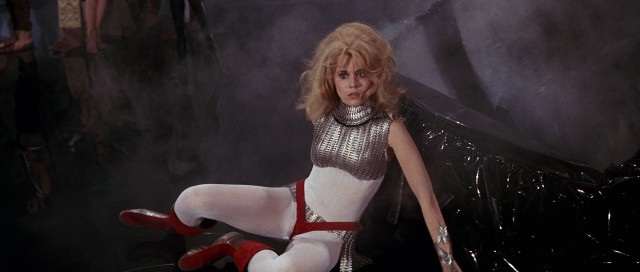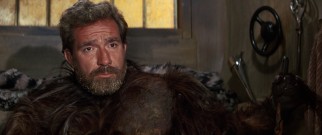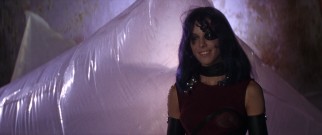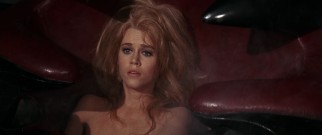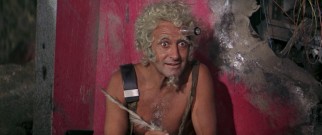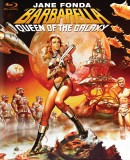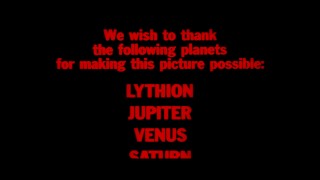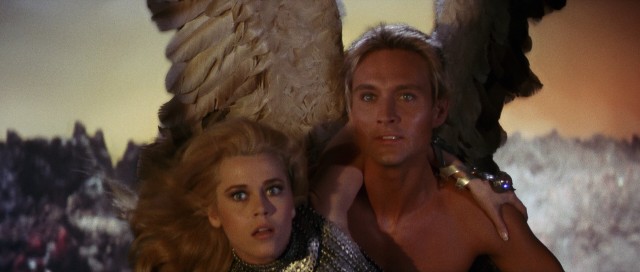Barbarella Blu-ray Review
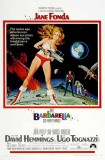 |
Barbarella
Theatrical Release: October 10, 1968 / Running Time: 98 Minutes / Rating: PG Director: Roger Vadim / Writers: Terry Southern, Roger Vadim (screenplay); Claude Brule, Vittorio Bonicelli, Clement Biddle Wood, Brian Degas, Tudor Gates (collaboration); Jean Claude Forest (collaboration & best seller) Cast: Jane Fonda (Barbarella), John Phillip Law (Pygar), Anita Pallenberg (The Great Tyrant/Black Queen), Milo O'Shea (Concierge/Durand Durand), Marcel Marceau (Professor Ping), Claude Dauphin (Dianthus, President of Earth), Veronique Vendell (Captain Moon), Serge Marquand (Captain Sun), Nino Musco, Umberto Di Grazia C.S.C., Giancarlo Cobelli, Franco Gula, Catherine Chevallier (Stomoxys), Marie Therese Chevallier (Glossina), David Hemmings (Dildano), Ugo Tognazzi (Mark Hand), Joan Greenwood (voice of The Great Tyrant - uncredited), Robert Rietty (voice of Professor Ping - uncredited) |
Buy Barbarella from Amazon.com: Blu-ray DVD Instant Video
Before she was a fiercely outspoken activist against the Vietnam War and the star of an incredibly popular line of exercise videocassettes, Jane Fonda was a young actress looking to make it in the industry where her father Henry had found great success. Jane began acting on stage in the 1950s and studied the craft at the Actors Studio run with the renowned Lee Strasberg. In 1968, Fonda got the first title role of her career, when director/screenwriter Roger Vadim, her husband at the time (her first marriage, his third), cast her in Barbarella, an adaptation of Jean-Claude Forest's series of adult French science fiction comics.
Barbarella is an Earth woman in the distant future. The film's theatrical reissue poster and now Blu-ray cover art give her the subtitle "Queen of the Galaxy", but you may find the heroine to be less of a queen and more of a slut, as she uses sex with most men she encounters to help her along on her mission. That mission, assigned to her by the government, is to track down Durand Durand (yes, the 1980s hit-making English band Duran Duran took their name from this film), a young inventor of the Positronic Ray, a powerful weapon that stands as a threat to the otherwise pacified planet.
Barbarella is sent to the planet Tau Ceti, where she crash-lands in the ice and forests of Weir. There, she is taken captive by some tough children and tormented by their creepy flesh-chomping dolls. Fortunately, a bear of a man named Mark Hand (Ugo Tognazzi) saves Barbarella from the cruel youths. He offers to repair her spaceship, too, in exchange for sex. Not the prevailing Earth mode of exaltation transference pills, but the "distracting" old-fashioned way.
The hairy Hand isn't the best of repairmen because Barbarella crashes again, immediately after taking off. This time, she gets stuck in the labyrinth of the City of Night, where a statuesque blind angel man named Pygar (John Phillip Law) helps her. She helps him too and their nest coitus manages to restore his long-absent will to fly. That comes in handy as he carries her and us to our next location, Sogo itself.
A city both more sophisticated and dangerous, Sogo is powered by an evil living fluid called the Mathmos. Barbarella catches the eye of Sogo's Great Tyrant, the Black Queen (Anita Pallenberg, then the partner of The Rolling Stones' Keith Richards) and her duplicitous Concierge (Milo O'Shea). Barbarella also runs into a disorganized, mustachioed, stocking-clad revolutionary named -- I kid you not -- Dildano (David Hemmings), who is happy to engage in the now standard hand-to-hand form of whoopy with her in exchange for an invisible key of great importance.
The work of famed Italian producer Dino De Laurentiis, his collaborations with Fellini long behind him and his American enterprises (from 1976's King Kong and Orca to Flash Gordon and Conan the Barbarian) yet to come, Barbarella is a curious film. To modern-day viewers, it looks like a clear B movie (and more like a C movie). And yet it cost $9 million, a plenty considerable sum back in 1968. To put that into perspective, in the same year, 2001: A Space Odyssey's budget was $10.5 M and Planet of the Apes spent just $5.8 M. Barbarella is as absurd on screen as it sounds in synopsis. Despite the high price tag, there is minimal production value. The artificial sets and visual effects seem horrendous by today's standards and are even feeble for back then (remember, same year as 2001 and Planet of the Apes). Of course, it's tough to criticize the film too strongly because it seems more designed to be erotica or farce than science fiction.
This movie must have seemed somewhat scandalous back in 1968, the same year that saw Hollywood abandon its long-standing production code (commonly known as the Hays Code) of moral censorship standards. Barbarella seems to capture the "free love" movement of the period we now classify as the sexual revolution. The film opens with its heroine essentially performing a zero-gravity striptease, as the titles scramble to cover her private parts. A good amount of near-nudity and semi-nudity follows, with a tiny bit of actual female exposure. Barbarella is dressed (and undressed) in ways that show off Fonda's shapely figure. She wears sparkly silver knee-high boots and an assortment of see-through garments, like the top that features what looks like a breast pump.
The film's ogling seems like the exploitation a young actress might endure with hopes of making it big, but in this case, Fonda was already an established 30-year-old star and the one doing the exploiting is her seemingly proud middle-aged husband. To add insult to injury, Fonda turned down starring in Bonnie and Clyde and Rosemary's Baby to make what remains one of the most embarrassing (but also best-known) of her few dozen film credits.
Barbarella was drubbed by critics and a flop at the box office. And yet, it was rereleased to theaters in 1977, receiving a PG rating from the MPAA and grossing a modest $613 thousand. While sequel plans fell apart in the 1970s (as did Vadim and Fonda's marriage), the director maintained interest in recasting the role until his death in 2000. Since that, there has been some interest in creating a remake, with director Robert Rodriguez and actress Rose McGowan becoming attached to the project at Universal in 2008. The studio backed out, though, and the only other one who would bite with a budget of $70 million wanted Rodriguez to shoot the R-rated film in Germany, which he refused to do, effectively killing the remake plans.
Barbarella seems like an odd choice to come to Blu-ray already, with Paramount only dipping into its massive catalog once a month these days. Nonetheless, it will make its format debut on July 3rd, thirteen years after premiering on DVD.
VIDEO and AUDIO Blu-ray preserves Barbarella's wide 2.40:1 original aspect ratio. The transfer features some grain, which is heavy in scenes employing rear projection. If you look hard, you'll also spot the occasional tiny blemish. For the most part, though, the movie looks good, boasting strong clarity and sharpness for its age. The high resolution allows you to see background seams and the strings from which "aircrafts" hang. Though you might expect the film's sci-fi stylings to inspire one of Paramount's common 5.1-channel remixes, the Blu-ray only presents the film in 2.0 monaural sound. On the default Dolby TrueHD, Shot at De Laurentiis' Rome studio, this international production filmed its scenes in both English and French, with the fluently bilingual Fonda performing her lines in both languages (while mime Marcel Marceau and Italian model Pallenberg had their English dubbed). That would add some appeal to the French track, if it used the French version visuals and the original soundtrack (instead of what is probably a more recent dub).
BONUS FEATURES, MENUS, PACKAGING and DESIGN As on DVD, Barbarella is joined by just one bonus feature: its original theatrical trailer (3:21), now presented in high definition. In general, the older a movie is, the more fascinating is its trailer and this long, dated, alliteration-appreciating preview upholds that notion. As if to make up for the lack of extras and boring menu (a static, silent swatch of the cover), Paramount treats the Blu-ray to a fancy cardboard slipcover that is extensively embossed and has a front that opens to reveal a wide display of another poster's retro artwork. It reinforces the film's pulp sci-fi feel. The disc does not resume unfinished playback, but does add bookmarks with a groovy graphic. The Blu-ray case, an eco-friendly one without the environmental pieces cut out, contains an insert elaborating on the slipcover sticker's mention of Paramount's centennial sweepstakes giving away a Delta vacation in the continental US.
CLOSING THOUGHTS With a less famous actress in the title role, it seems unlikely that Barbarella would have avoided obscurity. With political activist, fitness guru, author, and two-time Academy Award winner Jane Fonda in the part, though, this stupid sci-fi sex movie has somehow clung to relevance. Aside from bare legs and PG-rated sex scenes, the film's one primary asset is camp value, which it delivers in spades. Will that camp value and the allure of 1080p be enough to attract interest in this pricy, basic Blu-ray? My gut says no, but the disc's three-digit current Amazon.com sales rank suggests otherwise. Buy Barbarella from Amazon.com: Blu-ray / DVD / Instant Video
|
Related Reviews:
DVDizzy.com | DVD and Blu-ray Reviews | New and Upcoming DVD & Blu-ray Schedule | Upcoming Cover Art | Search This Site
1968: 2001: A Space Odyssey Planet of the Apes Once Upon a Time in the West
New: John Carter Journey 2: The Mysterious Island Men in Black II Spider-Man Ghost Rider: Spirit of Vengeance
Jane Fonda: The Best of The Colbert Report | Anita Pallenberg: Chιri | Milo O'Shea: The Verdict
Mystery Science Theater 3000: The Wild World of Batwoman Mystery Science Theater 3000: Girl in Gold Boots
Corman's World: Exploits of a Hollywood Rebel The Cat from Outer Space Unidentified Flying Oddball The Island at the Top of the World
2012 Paramount Blu-rays: Hondo To Catch a Thief Love Story Road Trip Chinatown Clueless
